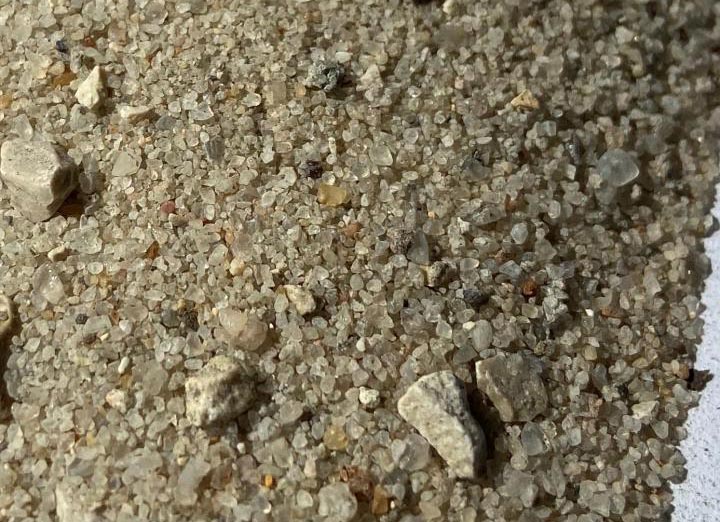Tracing the source of illicit sand–can it be done?

Sand
Image provided by Zachary Sickman
Research presented at the 2020 GSA Annual Meeting.
If you’ve visited the beach recently, you might think sand is ubiquitous. But in construction uses, the perfect sand and gravel is not always an easy resource to come by. “Not all sand is equal in terms of what it can be used for,” notes Zack Sickman, coauthor of a new study to be presented on Thursday at the Geological Society of America annual meeting. He says concrete aggregate needs sand with a certain size and angularity–the kind that is considered “immature” and often, but not always, found in rivers.
The demand for sand has exploded since WWII. “The consumption of sand and gravel and crushed rock started accelerating [after the Second World War] as a result of all the construction and infrastructure development and urbanization that was happening in many areas,” says Aurora Torres, coauthor of the study.
Although construction in Europe and North America has slowed, Torres notes that developing nations are experiencing rapid urbanization, and with it, an increased need for resources. The projected amounts of sand and gravel will likely jump from 35 gigatons per year (2011 levels) to 82 gigatons per year by 2060.
Sand mining, whether legal or illegal, has environmental and social impacts. Sand removal can affect agriculture, water quality, air pollution, sediment availability, and human health issues. While regulations can help lessen impacts, some of this extraction and transport is illegal and unmonitored. It’s this illicit trade that the team is focusing on.
Tracing Sand
The answer might be in the grains themselves. Sand is a strong forensic marker–it reflects the unique rocks within a drainage basin and keeps the record from extraction to construction. “There’s no reason why I couldn’t go take a core of concrete of an existing skyscraper and take that same compositional signature and tie it back to a source,” notes Sickmann.
Being able to quickly determine if mined sand is from an illegal area is an important step in tamping down illicit sand trade. Sickmann says that it’s possible to determine which river produced a truckload of sand, but “the real crux of the issue is finding the most effective way to use the method in a regulatory capacity.”
Sickmann and Torres want to find the most cost effective way to quickly and effectively fingerprint sand from different sources. They plan to start a proof-of-concept test on domestic (U.S.) sand first, where the sources and processing locations are well known. They and colleagues around the U.S. will collect concrete from home improvement stores and see if they can trace back the source of the sand. If they can successfully identify the catchment where the sand was sourced, they can move their methods to other global regions.
Eradicating Illicit Sand
The team thinks a quick sand fingerprinting method would be perfect for areas in Southeast and South Asia. “Not only are there areas of concern there with respect to illicit supply networks, the geology of Southeast Asia and South Asia is complex, and should provide a lot of leverage in distinguishing sand from different regional areas of concern,” notes Sickmann. The more diverse the rocks are in a basin, the easier it is to distinguish where the sand originated from.
Sand provenance identification is critical for reducing the impacts of illegal sand mining. “This is a very important issue,” says Torres. “I see this as a valuable tool that will be that will complement other strategies that are being put in place to track and monitor these illicit supply networks.”
###
CONTACT:
Zachary T. Sickmann
University of Texas at Austin
Email: ztsickmann@gmail.com
Paper No. 247-13: Mass Extinctions and Climate Change: Analogs of Today’s Rapid Climate Warming and Potential Biotic Catastrophe: https:/
Thursday, 29 Oct., 11:15 a.m. EDT
Session 187: T147. Anthropocene Sedimentology: Exploring Human-Sediment Interactions
https:/
The Geological Society of America, founded in 1888, is a scientific society with members from academia, government, and industry in more than 100 countries. Through its meetings, publications, and programs, GSA enhances the professional growth of its members and promotes the geosciences in the service of humankind. Headquartered in Boulder, Colorado, USA, GSA encourages cooperative research among earth, life, planetary, and social scientists, fosters public dialogue on geoscience issues, and supports all levels of earth science education.
All latest news from the category: Earth Sciences
Earth Sciences (also referred to as Geosciences), which deals with basic issues surrounding our planet, plays a vital role in the area of energy and raw materials supply.
Earth Sciences comprises subjects such as geology, geography, geological informatics, paleontology, mineralogy, petrography, crystallography, geophysics, geodesy, glaciology, cartography, photogrammetry, meteorology and seismology, early-warning systems, earthquake research and polar research.
Newest articles

High-energy-density aqueous battery based on halogen multi-electron transfer
Traditional non-aqueous lithium-ion batteries have a high energy density, but their safety is compromised due to the flammable organic electrolytes they utilize. Aqueous batteries use water as the solvent for…

First-ever combined heart pump and pig kidney transplant
…gives new hope to patient with terminal illness. Surgeons at NYU Langone Health performed the first-ever combined mechanical heart pump and gene-edited pig kidney transplant surgery in a 54-year-old woman…

Biophysics: Testing how well biomarkers work
LMU researchers have developed a method to determine how reliably target proteins can be labeled using super-resolution fluorescence microscopy. Modern microscopy techniques make it possible to examine the inner workings…





















